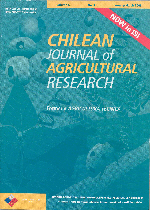
|
Agricultura Técnica
Instituto de Investigaciones Agropecuarias, INIA
ISSN: 0365-2807
EISSN: 0365-2807
Vol. 62, No. 3, 2002, pp. 463-468
|
 Bioline Code: at02043
Bioline Code: at02043
Full paper language: Spanish
Document type: Research Article
Document available free of charge
|
|
|
Agricultura Técnica, Vol. 62, No. 3, 2002, pp. 463-468
| en |
Effect of Temperature on Longevity, Reproduction, and Development of Trichogramma Nerudaiand Trichogramma Dendrolimi(Hymenoptera: Trichogrammatidae)
Zúñiga, Karinne H. & Gerding, Marcos P.
Abstract
Trichogramma nerudai
Pintureau & Gerding, was recently described in Chile, and there is
little information about the influence of the environment on its behavior.
Therefore, a comparative study with
Trichogramma dendrolimi
was carried out evaluating the longevity, reproduction, and development
stages of both species at 15, 20, 25, and 30ºC. Longevity and development
time decreased for both species as temperature increased,
T. nerudai
females being most affected. The life span of
T. nerudai
was greater than
T. dendrolimi
regardless of temperature. Highest parasitism of
Sitotroga cerealella
eggs was observed with
T. nerudai
at 20º and 25ºC. On average, each
T. nerudai
female parasitized 74.4
S. cerealella
eggs, whereas each
T. dendrolimi
female parasitized 43.7 eggs.
Keywords
biological control, egg parasitoid, parasitism, Sitotroga cerealella
|
| |
| es |
Efecto de la Temperatura en la Longevidad, Reproducción, y Desarrolo de Trichogramma Nerudaiy Trichogramma Dendrolimi(Hymenoptera: Trichogrammatidae)
Zúñiga, Karinne H. & Gerding, Marcos P.
Resumen
Trichogramma nerudai
Pintureau y Gerding, fue recientemente descrito en Chile y existe poca
información acerca de la influencia de medio ambiente en su comportamiento.
Por esta razón se realizó un estudio comparando a esta especie
con
T. dendrolimi
, evaluando la longevidad, reproducción y estados de desarrollo a
15, 20, 25 y 30ºC. La longevidad y tiempo de desarrollo disminuyó
en ambas especies a medida que la temperatura aumentó, siendo más
afectadas las hembras de
T. nerudai
. La duración del ciclo de vida fue más largo en
T. nerudai
que en
T. dendrolimi
, independiente de la temperatura. El máximo parasitismo de huevos
de
Sitotroga cerealella
lo realizó
T. nerudai
a 20 y 25ºC. Cada hembra de
T. nerudai
parasitó un total de 74,4 huevos, en promedio, comparado con hembras
de
T. dendrolimi
cuya mayor parasitación fue de 43,7 huevos.
Palabras-clave
control biológico, parasitoide de huevo, parasitismo, Sitotroga cerealella
|
| |
© Copyright 2002 - Instituto de Investigaciones Agropecuarias, INIA (Chile)
Alternative site location: http://www.inia.cl/at/agritec.htm
|
|
